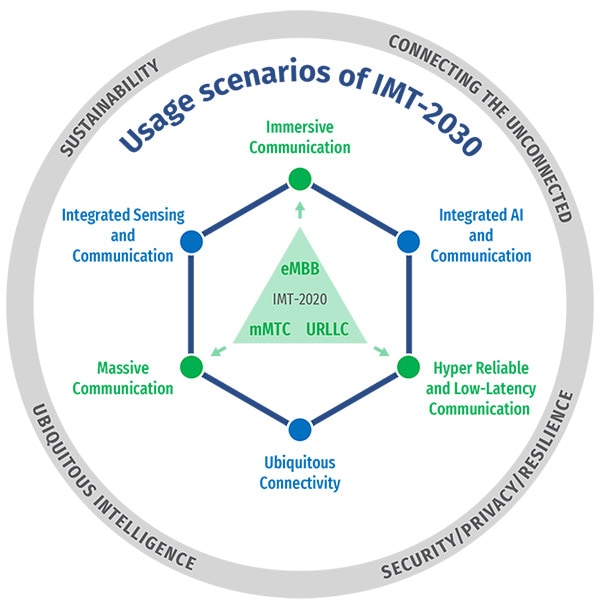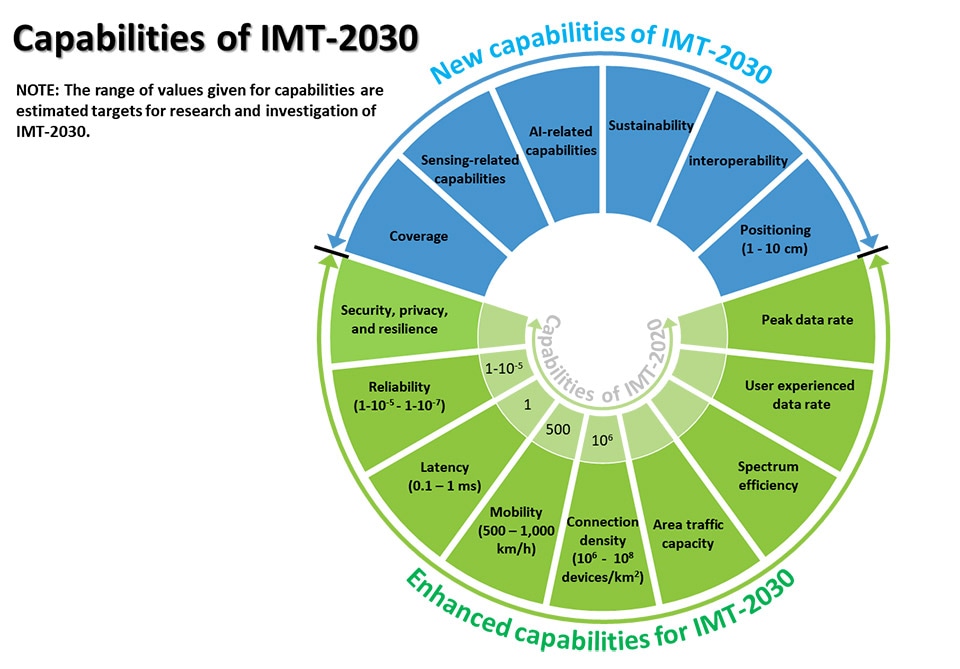IMT.FRAMEWORK FOR 2030 AND BEYOND
Draft new ITU-R recommendation (not yet approved): M.[IMT.FRAMEWORK FOR 2030 AND BEYOND]
Introduction:
At its 44th meeting in June 2023, ITU-R WP 5D finalized development of a draft new Recommendation ITU-R M.[IMT.FRAMEWORK FOR 2030 AND BEYOND] on “Framework and overall objectives of the future development of IMT for 2030 and beyond.” This draft recommendation is expected to be approved by year end 2023.
With the evolution of information and communications technologies, IMT-2030 is expected to support enriched and immersive experience, enhanced ubiquitous coverage, and enable new forms of collaboration. Furthermore, IMT-2030 is envisaged to support expanded and new usage scenarios compared to those of IMT-2020, while providing enhanced and new capabilities.
The objective of this Recommendation is to provide guidelines on the framework and overall objectives of the future development of IMT-2030 (aka “6G”).

In the next three years starting from 2024, ITU-R WP 5D will focus on the study of detailed technical performance requirements and the evaluation criteria and methodologies, paving the way for the technology proposal evaluation in the last phase of the IMT-2030 cycle, i.e. from 2027 to 2030.
Relationship between ITU-R (WP 5D) and 3GPP:
ITU-R WP 5D establishes the overall research and development direction, key performance indicators, as well as the standardization, commercialization, and spectrum roadmap for the new generation of IMT through a Framework Recommendation. It then moves on to defining the technical performance requirements to achieve the Framework.
After that, 3GPP develops detailed technical specifications that meet the requirements defined by the ITU-R recommendations and submits their specs to ITU-R WP5D (via ATIS) as a candidate radio interface technology. 5D then evaluates whether the 3GPP defined technology meets the requirements of the ITU-R (for 5G and presumably for 6G too). If it passes the evaluation process, it is approved as ITU-R Recommendation.
Figure 1. below shows these relationships:

Figure 1. Relationship between ITU-R and 3GPP
………………………………………………………………………………………………………………………….
Motivation and societal considerations:
The motivation for the development of IMT-2030 is to continue to build an inclusive information society and to support the UN’s sustainable development goals (SDGs). To this end, IMT-2030 is expected to be an important enabler for achieving the following goals, among others:
– Inclusivity: Bridging digital divides, to the maximum extent feasible, by ensuring access to meaningful connectivity to everyone.
– Ubiquitous connectivity: To connect unconnected, IMT-2030 is expected to include affordable connectivity and, at minimum, basic broadband services with extended coverage, including sparsely populated areas.
– Sustainability: Sustainability refers to the principle of ensuring that today’s actions do not limit the range of economic, social, and environmental options to future generations. IMT-2030 is envisaged to be built on energy efficiency, low power consumption technologies, reducing greenhouse gas emissions and use of resources under the circular economy model, in order to address climate change and contribute towards the achievement of current and future sustainable development goals.
– Innovation: Fostering innovation with technologies that facilitate connectivity, productivity and the efficient management of resources. These technological advances will improve user experience and positively transform economies and lives everywhere.
– Enhanced security, privacy and resilience: The future IMT system is expected to be secure and privacy-preserving by design. It is expected to have the ability to continue operating during and quickly recover from a disruptive event, whether natural or man-made. Making security, privacy and resilience key considerations in the design, deployment and operation of IMT-2030 systems is fundamental to achieving broader societal and economic goals.
– Standardization and interoperability: To achieve wide industry support for IMT 2030, future IMT systems are expected to be designed from the start to use transparently and member-inclusively standardized and interoperable interfaces, ensuring that different parts of the network, whether from the same or different vendors, work together as a fully functional system.
– Interworking: IMT-2030 is expected to support service continuity and provide flexibility to users via close interworking with non-terrestrial network implementations, existing IMT systems and other non-IMT access systems. IMT-2030 is also expected to support smooth migration from existing IMT systems, where including support of connectivity to IMT-2020 and potentially IMT-Advanced devices will be advantageous for inclusivity.
User and application trends:
Applications and services enabled by IMT-2030 are expected to connect humans, machines and various other things together. With the advances in human-machine interfaces, interactive and high-resolution video systems such as extended reality (XR) displays, haptic sensors and actuators, and/or multi-sensory (auditory, visual, haptic or gesture) interfaces, IMT-2030 is expected to offer humans immersive experiences that are virtually generated or happening remotely. On the other hand, machines are envisaged to be intelligent, autonomous, responsive, and precise due to advances in machine perception, robotics, and artificial intelligence (AI). In the physical world, humans and machines are expected to continuously interact with each other, working with a digital world that extends the real world by using a large number of advanced sensors and AI. Such a digital world not only replicates but also affects the real world by providing virtual experiences to humans, and computation and control to machines.
IMT-2030 is expected to integrate sensing and AI-related capabilities into communication and serve as a fundamental infrastructure to enable new user and application trends. From these trends, it is expected that IMT-2030 provides a wide range of use cases while continuing to provide, inter alia, direct voice support as an essential communication. Furthermore, IMT-2030 technology is expected to drive the next wave of digital economic growth, as well as sustainable far-reaching societal changes, digital equality and universal connectivity. IMT-2030 is expected to further enhance security, privacy, and resilience.

Source: Huawei
…………………………………………………………………………………………………………………………………………………………………..
Technology trends:
Report ITU-R M.2516 provides a broad view of future technical aspects of terrestrial IMT systems considering the timeframe up to 2030 and beyond, characterized with respect to key emerging services, applications trends, and relevant driving factors. It comprises a toolbox of technological enablers for terrestrial IMT systems, including the evolution of IMT through advances in technology and their deployment. In the following sub-sections, a brief overview of emerging technology trends and enablers, technologies to enhance the radio interface, and technologies to enhance the radio network are presented.
Emerging technology trends and enablers:
IMT-2030 is expected to consider an AI-native new air interface that uses AI to enhance the performance of radio interface functions such as symbol detection/decoding, channel estimation etc. An AI-native radio network would enable automated and intelligent networking services such as intelligent data perception, supply of on-demand capability etc. Radio networks that support AI services would be fundamental to the design of IMT technologies to serve various AI applications, and the proposed directions include on-demand uplink/sidelink-centric, deep edge, and distributed machine learning including federated learning.
The integration of sensing and communication functions in IMT-2030 systems would give new capabilities, enable innovative services and applications, and provide solutions with a higher degree of sensing accuracy. It would lead to benefits in enhancing performance and reducing overall cost, size, and power consumption of both systems, when it is combined with technologies such as AI, network cooperation, and multi-nodes cooperative sensing.
Computing services and data services are expected to become an integral component of the IMT 2030 system. It is expected to include processing data at the network edge close to the data source for real-time responses, low data transport costs, high energy efficiency and privacy protection, as well as scaling out device computing capability for advanced application computing workloads.
Device-to-device wireless communication with extremely high throughput, ultra-accuracy positioning and low latency would be an important communication paradigm for IMT-2030. Technologies such as THz technology, ultra-accuracy sidelink positioning, and enhanced terminal power reduction can be considered to support new applications.
Typical use cases for the 6 usage scenarios of IMT-2030:
| Immersive Communication |
|
| Massive Communication |
|
| Hyper Reliable & Low-Latency Communication |
|
| Ubiquitous Connectivity |
|
| Integrated AI and Communication |
|
| Integrated Sensing and Communication |
|
Source: Huawei
The Figure below summarizes the different dimensions of capabilities for IMT-2030, including 9 enhanced capabilities (peak data rate, user experienced data rate, spectrum efficiency, area traffic capacity, connection density, mobility, latency, reliability, and security/privacy/resilience) and 6 new capabilities (coverage, positioning, sensing-related capabilities, AI-related capabilities, sustainability, and interoperability). The range of values for the capabilities in the figure are estimated targets for research and investigation of IMT-2030. For each usage scenario, single or multiple values within the range would be developed in the future in other ITU-R Recommendations/Reports.

Source: Huawei
IMT-2030 envisages the use of a wide range of frequency bands ranging from sub-1 GHz up to sub-THz bands (low bands, mid bands (centimeterWave), mmWave bands and sub-THz bands). It expects that wider channel bandwidths may be needed to support future applications and services for IMT-2030 in a wide variety of deployments, including wide-area deployments. It is important to ensure that the current spectrum and newly assigned spectrum are harmonized.
References:
https://www.itu.int/md/R19-WP5D-230612-TD-0905/en (RESTRICTED TO TIES USERS)
https://research.samsung.com/blog/All-set-for-6G
IMT Vision – Framework and overall objectives of the future development of IMT for 2030 and beyond
Summary of ITU-R Workshop on “IMT for 2030 and beyond” (aka “6G”)
China’s MIIT to prioritize 6G project, accelerate 5G and gigabit optical network deployments in 2023


